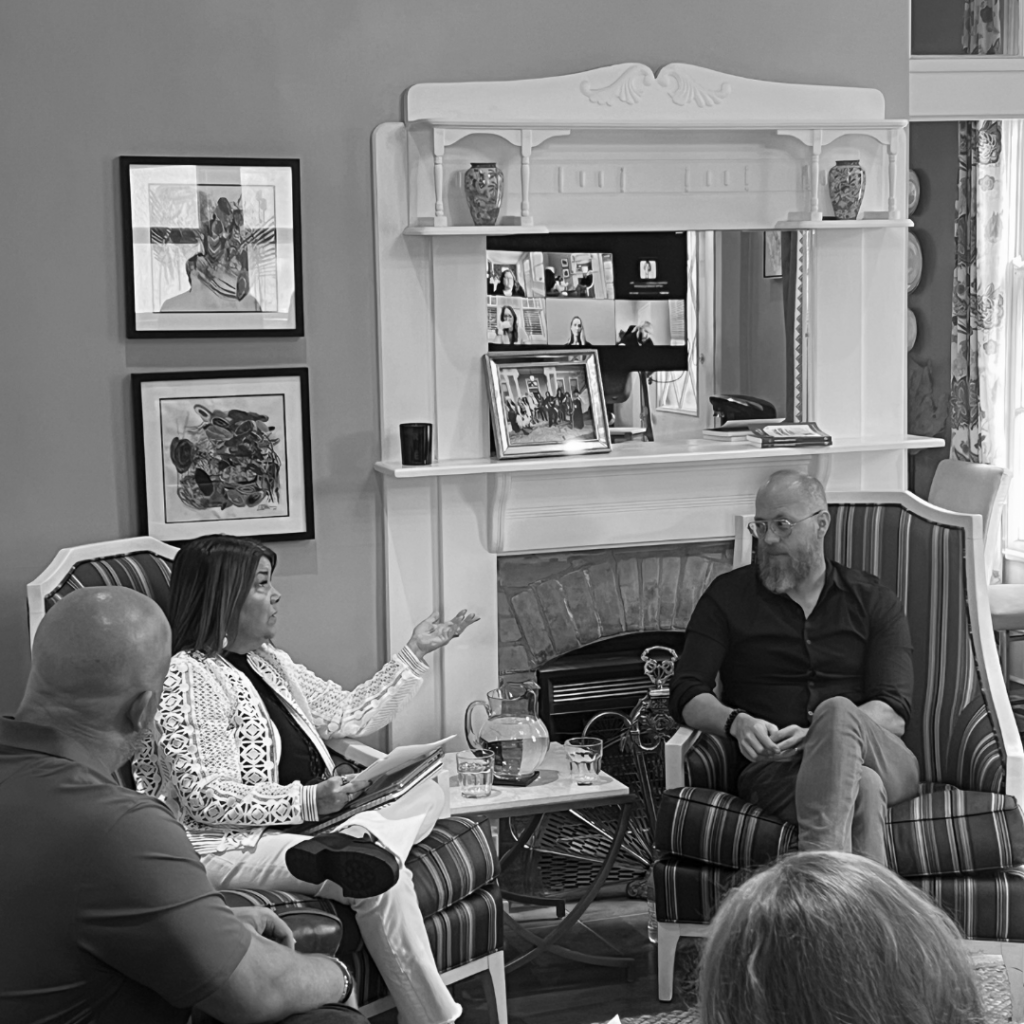Douglas Ferguson, the president of Voltage Control and the co-author of “The Non-Obvious Guide to Magical Meetings,” stopped by the office for the first installment of Red Fan’s salon series, a platform for people with interesting and innovative ideas on work, technology and the world around us.
Red Fan’s CEO and founder, Kathleen Lucente, first discovered Douglas’s work while preparing to facilitate Red Fan’s first post-pandemic client workshops. “Magical Meetings” proved invaluable for Red Fan and ultimately our clients.
Using “Magical Meetings” as our foundation, Red Fan has reinvigorated our culture around meetings, built better facilitators within our staff and overhauled the format of our most important meetings. During his fireside chat with Kathleen, Douglas shared his invaluable insights with our clients, partners and other friends from the Austin community.
The following Q&A has been edited for length and clarity.
Kathleen Lucente (KL):
Douglas, the premise of your book is that meetings suck—and yet you point out that meetings are one of the most powerful tools we have. What was your inspiration to write a book on meeting culture in the first place?
Douglas Ferguson (DF):
I think it was just a career of abuse, of being part of so many poorly run meetings. Reflecting over my career, the thing that always separated me from other chief technology officers was my deep interest in people and systems and how we get to a point of high efficiency through creating sustainable work practices. I was always really keen on exploring how to gather a team in really interesting and powerful ways—but that wasn’t always prioritized by the rest of the organization. “Magical Meetings” was conceived as a way to give people a bit of a simple guide, a toolkit to improve their everyday meetings.
KL:
One of the things you talk about is being a “Magical Meeting Jedi,” and the fact that there’s a real responsibility in being a facilitator—whether you’re holding a 15-minute client call or an hours-long brainstorm. What are the ways you know you’re being a Magical Meeting Jedi, and how do you know when you are floundering?
DF:
In the book, we say there’s no such thing as bad meetings, just bad facilitators. When you think about a bad meeting you walked out of, who was that bad facilitator? Who called the meeting but lacked the foresight to say, “I’m going to make this incredible”? The most expensive assets available to us are our people. If we’re bringing people together, let’s be intentional about how we’re going to get the most out of it. The most important thing a facilitator can do is clarify the purpose of the meeting so everyone walks into the room (or Zoom) with the same goal in mind.
KL:
How do you bridge the digital divide to ensure equal meeting engagement for virtual participants?
DF:
I always recommend when we’re conducting a hybrid meeting that we have three meeting facilitators: One facilitator who is mindful of the experience of the people in the room, one facilitator who is mindful of what it’s like to be in the digital space and one facilitator who is observing the boundary between the two. It’s almost impossible for one person to effectively cover all three of those roles.
KL:
One of the mantras in your book is “disagree and commit.” Can you expand on that idea a bit?
DF:
A lot of people will say “agree to disagree,” but my philosophy is a little different. During World War II, the Office of Strategic Services published its “Simple Sabotage Field Manual,” which was a guide distributed to Allied sympathizers in companies in Axis-controlled territories to help them disrupt the effectiveness of those companies without getting caught. Once you’ve read that manual, you’ll recognize that the OSS’s guidelines for effective sabotage are the exact same things that happen in every company you’ve ever worked at. One of the biggest opportunities for sabotage is to open up every decision for additional debate. When I talk about “disagree and commit,” that’s an active effort to fight against analysis paralysis. So many of the decisions we make are reversible—as long as you’re approaching the process with a prototyping mindset, you’re almost never stuck with the first commitment as your final product.
I also like to draw the line between consensus and unanimity. You will almost never see unanimity in an effective organization, because it’s very difficult for smart people with different viewpoints to get 100% aligned on every decision. When you have unanimity, what you actually have is an organization where people aren’t comfortable voicing dissenting opinions. In contrast, building consensus means that, even if we haven’t reached perfect alignment, we’re all comfortable moving forward with an idea.
KL:
How do you deal with meeting participants who we’d call difficult—who don’t participate effectively, or who derail the purpose of your meeting?
DF:
The first thing I teach every facilitator-in-training is that you have to stop thinking of people as “difficult” participants. When you label your meeting participants as difficult in advance, you guarantee that you won’t be successful. The key is to look inward and ask, “How am I as a facilitator causing this problem?” People act out of frustration when they lack clarity, and the clarity that’s most often missing when we set meetings is identifying the purpose of the meeting. In the meetings I facilitate, I take the time to explain the benefit of every item on the agenda, ensuring we reach collective buy-in and maximize the value of the meeting for every participant.
KL:
How do you respond and correct in the moment when you can feel that a meeting is going downhill?
DF:
The best tool in my toolbox for these situations is leaning into the conflict. As humans, we often take a conflict-avoidance strategy wherever we can, but that’s not always conducive to effective conversation. A skilled facilitator is going to lean into conflict when they feel it by creating a safe environment for everyone to express their opinions while minimizing the potential for someone to feel hurt. When conflict rears its head in a meeting, sometimes labeling it is the most effective thing we can do. I like to ask, “Did anyone notice how that felt a little uncomfortable?” Stepping up and being the one to address the conflict can help cut through any tension and give the meeting participants permission to address the root of the conflict and keep the meeting on track.
If you’d like to learn more about Douglas’s philosophy and get your own copy of “Magical Meetings,” you can visit his website.
Did you find this Q&A valuable? Sign up for Red Fan’s newsletter to ensure you stay in the loop on our upcoming workshops and events.





